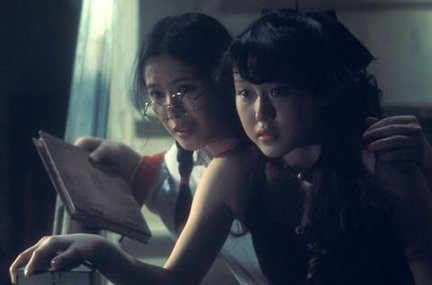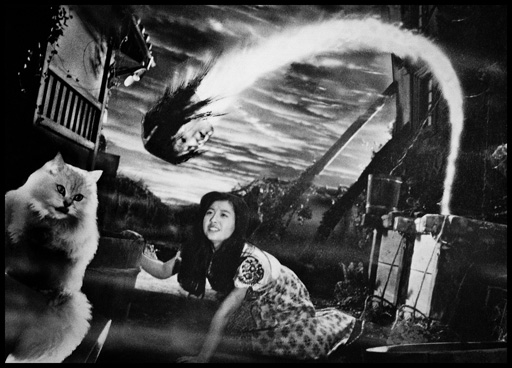My favorite movie subgenre is the haunted house film. Jack Clayton’s The Innocents (based on Henry James’ Turn of the Screw), Robert Wise’s Shirley Jackson adaptation The Haunting, Lewis Allen’s The Uninvited, John Hough and Richard Matheson’s The Legend of Hell House, Stanley Kubrick’s The Shining, and more recent films like The Others (which inverts the genre), The Devil’s Backbone, The Orphanage, and Paranormal Activity all illustrate how much drama can be generated from the simplicity of actors reacting to bumps in the night—perhaps the most immediately relatable of horror film tropes. The best of these films take the Val Lewton ethos of using shadows and implication—noises beyond walls, shapes glimpsed in dark corners, and a suffocating helplessness—to generate fear and dread. Typically this is all draped in some lovely Gothic accoutrements.
And then you watch a spookshow like Nobuhiko Obayashi’s House, and none of these rules apply, and you don’t even know what the hell you’re looking at.
Schoolgirl Gorgeous is upset that her father is remarrying (a woman who is perpetually shot in slow-motion while a fan kicks up her fluttering hair); so she runs away with her six friends to spend a holiday with her aunt, a widow who lives in a towering, menacing House! severed from the real world by a high wall. (Not that the real world is in evidence on either side of that wall, in this particular film.) All the girls, like Snow White’s seven dwarves, have names which describe all you need to know about them. Apart from Gorgeous, there is Fantasy, Prof, Melody, Sweet, Mac (the chubby one), and my favorite, Kung Fu, whose skill seems to be kicking objects out of the air as they hurtle toward her head while a frenetic 10-second loop of library music plays, and who spends the last half of the film, pleasingly, without any pants. The last companion on their candy-colored, pop-music-driven journey* to Auntie’s House is a mysterious white feline with glowing green eyes and an apparent working knowledge of train schedules.
Once they arrive, twenty-five minutes into the film, the wheelchair-bound Auntie greets the girls warmly, but events start going haywire pretty quickly. Shortly after they step through the door, the following sequence occurs, lasting only a few seconds.
1) Melody’s hat flies off her head on a vertical path.
2) Kung Fu spins around dramatically.
3) Red and green flashes light up the chandelier overhead, and a pointed crystal shard drops from it.
4) Kung Fu dodges the crystal shard.
5) The shard impales a lizard on the floor. Its tail wriggles.
6) Melody screams while the room spins about her.
7) Slow-motion zoom on Kung Fu.
8) A shot of Kung Fu leaping through the air toward the chandelier is fast-intercut with a shot of the cat on a similar trajectory, apparently leaping at least seven feet off the ground.
9) Kung Fu’s hand karate-chops another dropping crystal shard. This shot is so brief that you can barely see it without pausing the film.
10) The shard flies horizontally toward an antique telephone hanging on the wall.
11) The shard becomes lodged in the mouthpiece cup of the telephone.
12) Kung Fu lands on the floor.
13) Melody’s hat drops back onto her head. She says, “Well done! You’re so cool, Kung Fu.”
14) The cat walks over to the impaled lizard and begins to eat it. This is followed by an iris-in transition to blackness to end the scene.
Although this is an extreme example, much of House is like this. Obayashi acts more like the director of an animated short—say, a Chuck Jones—than anyone who had hitherto worked in the house of Toho. The casual surrealism is more pop-art (and Saturday morning cartoon) than Buñuelian, although Buñuel, in the unlikely event that he ever saw the film, might have enjoyed the trippy sequence just a short journey further in, when Fantasy goes in search of the missing Mac. After commenting on the “beautiful sunset”–a deliberately artificial matte painting–she pulls at the rope of a well, intending to retrieve the watermelon sunk there earlier, in lieu of a working refrigerator. Rather than the melon, she pulls up Mac’s severed head, which grins at her and calls her name. Fantasy screams and flees, and Mac’s head floats through the air, spins, and swoops down to bite Fantasy’s behind. “Tasty!” she declares. Then the head is flung back to the well, where it vomits bloody well-water, and drops clumsily backwards. Alas, when Fantasy returns with her friends in tow, no one will believe her story, for her name is Fantasy, after all.
Very soon all the girls will realize something is horribly wrong with the House. Disconcerting enough that Auntie doesn’t seem to really need her wheelchair after all—oh, and is briefly glimpsed chomping on an eyeball. But shortly after Mac’s disappearance, Gorgeous has a ghostly encounter in the bathtub, Kung Fu is attacked by pieces of flying firewood, Auntie dances with both the cat and a string-operated skeleton, and, in the film’s tour de force, Melody becomes possessed by the piano she is playing, and is then eaten by it, piece by piece, until only her severed fingers are left playing the keys. This memorable scene is accomplished using the same bizarre style of special effects which permeate the entire film: choppy bluescreen work, animation of various styles, and such extreme stylization that it evokes an underground film aesthetic as well as the notebook doodles of a distracted schoolboy. It’s also edited within an inch of its life. Obayashi barely lets a transition pass that isn’t ingenious in one way or another; my favorite is when a man stuffing his face with noodles suddenly plunges into a sequence in the House, grotesquely leaning right into the girls’ faces—cut to that man in the noodles shop some several miles distant for a scene which then proceeds as normal. When I first saw this film, on the revival circuit last year, such relentless innovation was exhausting. As much as I enjoyed the film, I was ready for it to end about twenty minutes before it did. But House gets better, and certainly less exhausting, on repeated viewings, as you begin to notice more details (and jokes).

By the time of the film’s release in 1977, House was only the latest installment in a rich cinematic lineage of Japanese ghost stories. Nonetheless, the playful, postmodern approach of Obayashi—a contemporary of the groundbreaking Japanese New Wave, and a bold experimentalist in both short films and television commercials before making this, his belated debut feature—was a radical departure for Toho Studios, and pointed the way toward the greater extremes of self-conscious Japanese pop-art that would soon begin appearing more frequently in Japanese films, television, and manga. As the director describes on the recent Criterion Blu-Ray, prior to House’s release there was a radio adaptation, manga, novelization, and soundtrack LP; the actual film might have been an afterthought to Obayashi’s media blitz. But this seems to have given Obayashi greater license to put quotation marks around the material. House feels like an adaptation of an earlier, non-existent House, like the umpteenth sequel in an old franchise, long decayed into parody and self-referential fun. Naturally, it could be argued that it’s strictly genre parody, but there’s a great deal of genuine feeling here too. Beneath all its giddy technique there lurks the angst of an emotionally tortured teenager.** Fundamentally the movie works right down to its coda, which is both bittersweet and delightfully sinister.
* Pop group Godiego appear as themselves and provide the film’s soundtrack. They would later provide music for the classic anime Galaxy Express 999.
** Appropriately enough, Obayashi came to specialize in films about teens, including the 1983 film The Little Girl Who Conquered Time, whose unofficial animated sequel, The Girl Who Leapt Through Time (directed by Mamoru Hosoda) is one of the best anime films of recent years.












